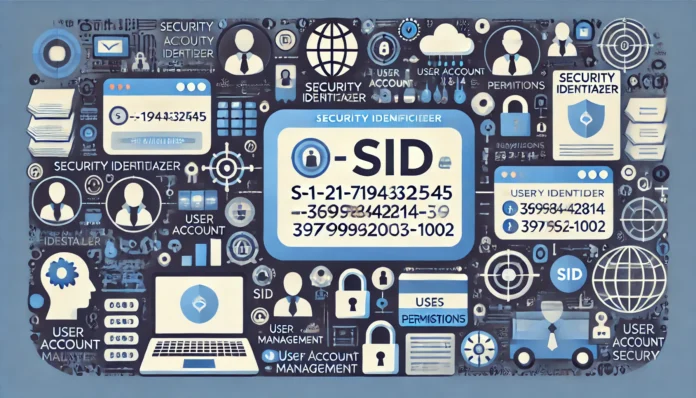Alright, so you’ve seen this cryptic sequence, “s-1-5-21-719432545-3696842814-3937962003-1002,” somewhere in your system, and it’s got you scratching your head. Maybe you’ve stumbled upon it in your computer’s logs or system permissions, and you’re wondering, what’s the deal with it? Well, let’s break it down in simple terms.
This sequence is what’s known as a Security Identifier (SID) in Windows systems. Now, before you think, “I don’t do tech,” don’t worry, I’ll explain it like we’re just having a chat over coffee. An SID, like s-1-5-21-719432545-3696842814-3937962003-1002, is essentially a unique ID for user accounts and groups in Windows.
Why Should You Care About s-1-5-21-719432545-3696842814-3937962003-1002?
So why does this SID even matter? Well, here’s the thing: SIDs are critical in identifying and managing user permissions on your computer. This specific SID, s-1-5-21-719432545-3696842814-3937962003-1002, points to a user account that exists on your system. Imagine you’re in an office, and every employee has a badge with a unique number—SIDs are like those badge numbers for your system accounts.
The SID ensures that your personal files and settings are accessed only by you, not someone else on the system. If this SID popped up while you were troubleshooting an error or setting up user permissions, you’re in the right place. It’s the key to managing who gets access to what on your computer.
Real-Life Example: Why SIDs Can Be Your Best Friend in Troubleshooting
Let’s say you’re sharing a computer with family members, and everyone’s complaining they can’t access their stuff. You might check the SIDs to confirm who owns what files or which user has certain permissions. That way, you can solve the problem without any drama.
How to Decode “s-1-5-21-719432545-3696842814-3937962003-1002”
At first glance, s-1-5-21-719432545-3696842814-3937962003-1002 looks like a random string of numbers. But, there’s actually a method to this madness. Here’s a quick breakdown:
- The “S” at the beginning: It stands for Security.
- The “1” that follows: Indicates the SID version.
- The “5”: Identifies it as a Windows NT SID.
- The long middle part: This is the domain or local machine identifier.
- The last section: 1002 refers to the unique user account or group.
Understanding this structure helps when you’re digging through system settings and trying to make sense of user permissions.
Navigating Common Problems with SID s-1-5-21-719432545-3696842814-3937962003-1002
Now that you know what an SID is, let’s talk about some common scenarios where you might bump into s-1-5-21-719432545-3696842814-3937962003-1002. There are a few headaches that SIDs can cause, especially when they get misconfigured or when accounts get deleted.
Problem #1: Deleted Accounts with SID Remnants
Ever tried to delete a user account, only to see their SID lingering around? It happens, and it can be annoying. If you see s-1-5-21-719432545-3696842814-3937962003-1002 without a username attached, the account might’ve been deleted, but its SID stuck around.
How to fix it:
- Head to the Registry Editor and manually remove the orphaned SID.
- Or, you can use third-party cleanup tools designed to clear up these remnants.
Problem #2: Permission Issues Tied to Specific SIDs
Another common issue is when you have trouble accessing certain files or folders due to SID-specific permissions. If s-1-5-21-719432545-3696842814-3937962003-1002 has restricted access on a folder, you won’t be able to open it.
How to fix it:
- Right-click on the folder, go to Properties > Security, and manually adjust the permissions for that SID.
- Use Command Prompt to modify permissions using commands like
icaclsfor a more advanced approach.
Problem #3: Duplicate SIDs in Cloned Systems
If you’ve cloned a system or created a new virtual machine, you might end up with duplicate SIDs, which can confuse your network and create permission conflicts. No one wants a bunch of computers that all think they’re the same person!
How to fix it:
- Use sysprep in Windows before cloning.
- Run tools like NewSID or SIDchanger to update duplicate SIDs.
FAQs about s-1-5-21-719432545-3696842814-3937962003-1002
What’s the easiest way to find my own SID?
It’s simple! Just open Command Prompt and type whoami /user. This command will instantly display your SID.
Can I change my SID?
Not directly. SIDs are meant to be unique, and changing them can mess up your system. Instead, if you need to create a fresh SID, it’s better to create a new account.
How can I use SIDs to enhance security?
By using SIDs, you can set specific permissions for users and groups on your system. Think of it as setting individual passwords for files. This way, only certain SIDs can access sensitive information, keeping it safe.
Wrapping Up the Mystery of s-1-5-21-719432545-3696842814-3937962003-1002
Now that you’ve decoded the mysteries behind s-1-5-21-719432545-3696842814-3937962003-1002, you’ve got a better handle on how these identifiers work. They’re like backstage passes, controlling who gets into which parts of the computer.
This SID may seem like a random string of numbers, but it’s actually a critical tool for maintaining control over your system. Whether you’re troubleshooting access issues, setting up new accounts, or cleaning up deleted ones, understanding SIDs can save you a lot of headaches.
So, next time you see s-1-5-21-719432545-3696842814-3937962003-1002 pop up, you’ll know exactly what’s going on.
